
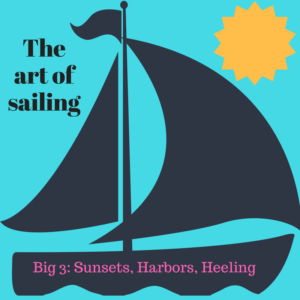
 Sunsets are immortal. They convey the end of a day, and if that day was spent on the water, all the better. The romance of the evening combines with the adventure of the boat. This is why wine was invented.
Sunsets are immortal. They convey the end of a day, and if that day was spent on the water, all the better. The romance of the evening combines with the adventure of the boat. This is why wine was invented.  2. Pirates are dangerous. They convey the mystery of the sea like no other. Colonial Williamsburg has built historic programming around the famous Blackbeard even though his connection is tenuous (he was jailed briefly here). My competitor sailing charter Alliance has a Saturday program devoted to pirates even though there were none here in the 18th century.
2. Pirates are dangerous. They convey the mystery of the sea like no other. Colonial Williamsburg has built historic programming around the famous Blackbeard even though his connection is tenuous (he was jailed briefly here). My competitor sailing charter Alliance has a Saturday program devoted to pirates even though there were none here in the 18th century. 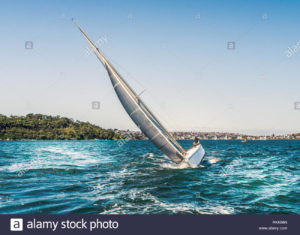 3. Heeling shows speed. We spend most of our time here at Let’s Go Sail. To explain the dynamics of sailing, one has to appreciate the effect of the wind on the boat. It tilts the entire vessel 10 or 15 degrees. When we tack, we heel on the other side. Sailboats are supposed to heel, and they represent the universal look. We find it in paintings, post cards, cocktail napkins, and logos on shirts. It takes a minute or two for a rookie to realize the boat won’t lean any further or tip over on its side. Once a sailor gets a grip on heeling, it becomes addictive. Faster, faster!
3. Heeling shows speed. We spend most of our time here at Let’s Go Sail. To explain the dynamics of sailing, one has to appreciate the effect of the wind on the boat. It tilts the entire vessel 10 or 15 degrees. When we tack, we heel on the other side. Sailboats are supposed to heel, and they represent the universal look. We find it in paintings, post cards, cocktail napkins, and logos on shirts. It takes a minute or two for a rookie to realize the boat won’t lean any further or tip over on its side. Once a sailor gets a grip on heeling, it becomes addictive. Faster, faster!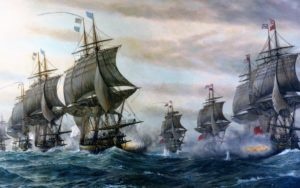 5. War scenes have a long history, much of it in the form of propaganda. The most famous painting locally is the Battle of the Capes, depicting the sea battle between the French and British that set up the momentous Siege of Yorktown that ended the Revolutionary War.
5. War scenes have a long history, much of it in the form of propaganda. The most famous painting locally is the Battle of the Capes, depicting the sea battle between the French and British that set up the momentous Siege of Yorktown that ended the Revolutionary War.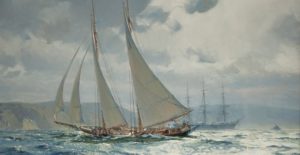
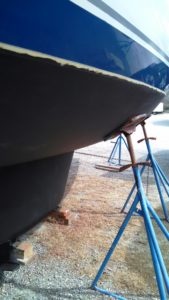 On another mundane level, the other painting has to do with the hull of the boat. This is all the Fiberglas from the water line down to the bottom of the keel. In the first illustration of “Heeling to port,” look how the waterlineshows up as the boat leans over.
On another mundane level, the other painting has to do with the hull of the boat. This is all the Fiberglas from the water line down to the bottom of the keel. In the first illustration of “Heeling to port,” look how the waterlineshows up as the boat leans over. Painting the hull requires hauling the boat at the marina yard in a huge Travel Lift that scoops it up with two big slings. They motor the boat to a nearby place on the hard surface of the yard. Then they prop it up straight with three steel stanchions on each side and one under the bow.
Painting the hull requires hauling the boat at the marina yard in a huge Travel Lift that scoops it up with two big slings. They motor the boat to a nearby place on the hard surface of the yard. Then they prop it up straight with three steel stanchions on each side and one under the bow.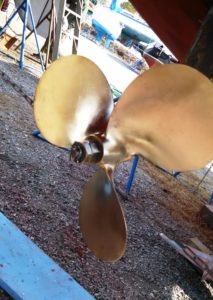 While the boat is out of the water, it’s time to sand down the brass prop and paint it with nine coats of blended bottom paint. Finally, the position of the boat makes it possible to compound and wax the hull, which is nearly impossible while the boat is in the water. The entire three-step process can be done in 10 days, then back into the water to start the new season.
While the boat is out of the water, it’s time to sand down the brass prop and paint it with nine coats of blended bottom paint. Finally, the position of the boat makes it possible to compound and wax the hull, which is nearly impossible while the boat is in the water. The entire three-step process can be done in 10 days, then back into the water to start the new season.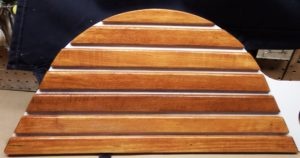 The other painting that is tedious but worth it is varnishing teak, namely the catbird seats. Every winter they have to be removed from the boat to the workbench at home. The slats are dissassembled for sanding, usually just enough to scuff so as to take fresh coats. Two or three coats are sufficient for hundreds of guests to occupy their perch over the course of the season. Few people realize the detail that goes into making the seats gleaming. Every now and then a woodworker will admire them. Mostly people just want to sit there and take in the view from on high.
The other painting that is tedious but worth it is varnishing teak, namely the catbird seats. Every winter they have to be removed from the boat to the workbench at home. The slats are dissassembled for sanding, usually just enough to scuff so as to take fresh coats. Two or three coats are sufficient for hundreds of guests to occupy their perch over the course of the season. Few people realize the detail that goes into making the seats gleaming. Every now and then a woodworker will admire them. Mostly people just want to sit there and take in the view from on high. Finally we get to the interior teak. Just as the exterior teak is varnished to resisit sunlight, the interior teak has a softer glow of satin since no varnish is required. It nonetheless requires finishing more than painting, namely with teak oil. After carefully brushing it on, one rubs the teak to spread it around and sink in uniformly. That’s a challenge because the salon is full of mismatched teak that has be united in finish. Wait 15 minutes and wipe it down hard to remove any residue film. Last summer I got caught in a squall and sent a family below for safe keeping. I couldn’t very well shut them in for fear of claustrophobia as the boat tossed and turned in a 59 mph gail. As a result, the drill of the driving rain scoured the teak finish right off the wood, leaving the cabin looking the inside of a grey coffin.
Finally we get to the interior teak. Just as the exterior teak is varnished to resisit sunlight, the interior teak has a softer glow of satin since no varnish is required. It nonetheless requires finishing more than painting, namely with teak oil. After carefully brushing it on, one rubs the teak to spread it around and sink in uniformly. That’s a challenge because the salon is full of mismatched teak that has be united in finish. Wait 15 minutes and wipe it down hard to remove any residue film. Last summer I got caught in a squall and sent a family below for safe keeping. I couldn’t very well shut them in for fear of claustrophobia as the boat tossed and turned in a 59 mph gail. As a result, the drill of the driving rain scoured the teak finish right off the wood, leaving the cabin looking the inside of a grey coffin.
Learning to Sail recounts the thrill of going fast on 3 reaches.
John Baker of nearby Gloucester and Joshu and Maryanne Gobrogge of Hancock MI joined up for an afternoon sailing lesson. Joshua has a small boat that he sails on a pond, while John is planning to circumnavigate the world. “Well, first I have to circumnavigate the Chesapeake Bay. I’ve always
